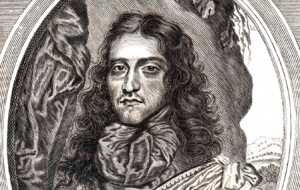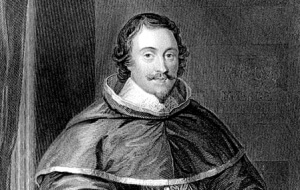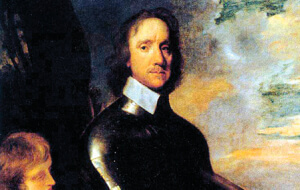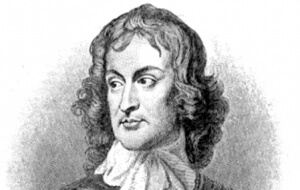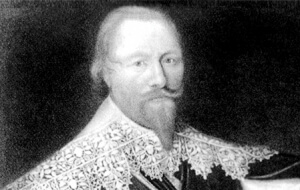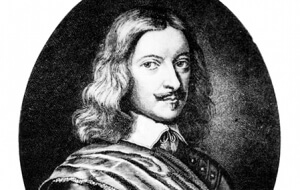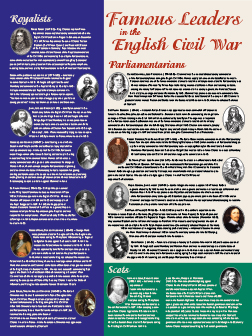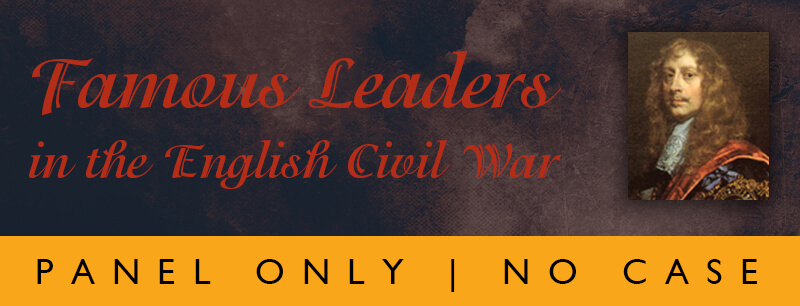
Royalists
King Charles’s nephew Prince Rupert was an accomplished cavalry commander before the English Civil Wars. Born in Prague in Bohemia on December 17, 1619, Prince Rupert was the son of Charles I’s sister Elizabeth (the “Winter Queen”) and Frederick V, Elector of the Palatinate in Germany. Rupert became the most romantic, successful and famous of the Royalist commanders of the Civil Wars and was widely feared by the Parliamentarians, some of whom credited him with supernatural powers. His dog Boy (a standard poodle), which had a price placed on his head, accompanied Rupert everywhere, including battle, and was said by Parliamentarians to be the Prince’s evil familiar spirit.
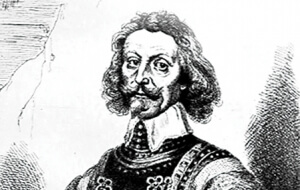
Lord Astley was a veteran of the Thirty Years War who returned to England to serve Charles I in 1638. He fought at Edgehill and Second Newbury and commanded the Royalist infantry at Naseby in 1645. Astley commanded the last Royalist field army to surrender in 1646. He is famously quoted as telling his Parliamentarian captors, “You have now done your work and may go play unless you fall out among yourselves.” Astley was known as an honest and brave man.
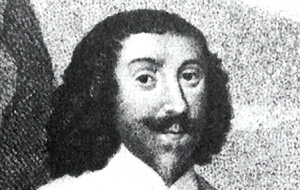
Lord Byron served in the Dutch army before the English Civil Wars. He was one of the first to join the king’s forces in 1642 and fought at Powick Bridge, Edgehill and Newbury. As an independent commander, he had a mixed record, but is best known for his stubborn defense of Chester from September 1645 through February 3, 1646. After unsuccessfully trying to raise troops in Wales in 1648, Byron went to France, where he died in 1652.
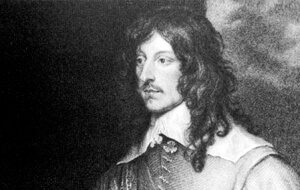
Lord Goring served with the Dutch in the Thirty Years War and suffered an injury that left him with a permanent limp. At the start of the Civil War, Parliament made him governor of Portsmouth. Goring decided to join the king instead and fought in numerous battles. He was at his best as a cavalry commander, and his greatest achievement was his charge at Marston Moor, where he swept away the Parliamentarian right wing and almost won the battle. Unfortunately, he had a reputation for gaming, drinking and harshness, and his troops were known for indiscriminate plundering, making Goring a hated man among Parliamentarians. He was beheaded in 1657 for attempting to start a rebellion against Cromwell in Kent.
Sir Ralph Hopton served in the Thirty Years War where he became friends with William Waller, his future opponent in the English Civil Wars. He was a Member of Parliament in 1621 and 1625 and was captain of the Royal Bodyguard in 1639. In 1642, the king appointed Hopton Lieutenant General of the West. As a general, Hopton was second only to Prince Rupert among the Royalists and was responsible for many victories. After his defeat by Sir Thomas Fairfax at Torrington in 1646, Hopton surrendered and went into exile, where he died in 1652.
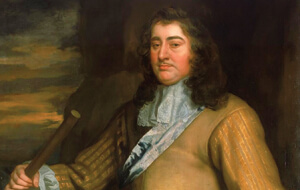
George Monk was a professional soldier throughout his life. He fought in the Netherlands during the Thirty Years War, returning to England to fight for Charles against the Scots in 1639. In 1641 he was sent to Ireland, where he remained until 1643. In 1644 he was captured by Lord Fairfax and spent two years as a prisoner in the Tower of London. He joined Parliament in 1646, when it was clear the king was defeated. He was sent to Ireland with the New Model Army, where he served as governor of Ulster until 1649. Monk then served under Cromwell at the battle of Dunbar and was given command of the English troops in Scotland in 1651. He was next successful commanding ships against the Dutch in the First Dutch War, before returning to Scotland. After Cromwell’s death, Monk was largely responsible for the success of the Restoration, ensuring the acceptance of Charles II by the army. Charles II made him Duke of Albemarle, and his regiment became the famous Coldstream Guards.
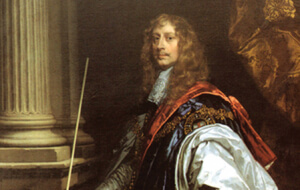
The Earl of Ormonde was Charles I’s commander in Ireland throughout the English Civil Wars. Through battle and political skill, he was able to send reinforcements to the king during the First Civil War. After 1646 Ormonde had to face both the Irish Catholic rebels and Parliamentary forces. He withdrew from Ireland in 1647, but returned the following year as the Second Civil War broke out. He was finally defeated by Cromwell and joined Charles II in exile in France. At the Restoration, Ormonde was again made Lord-Lieutenant of Ireland by Charles II.
Parliamentarians
Cromwell was the most celebrated cavalry commander of the Parliamentary forces during the English Civil Wars. He was equally at home on the battlefield as he was in Parliament and was one of the few commanders allowed to retain his military command and his Parliamentary seat. He was nicknamed “Ironside” by Prince Rupert after being wounded at Marston Moor and returning to battle, ensuring the victory for Parliament. The nickname was extended to his cavalry regiment, the “Ironsides,” famous for its discipline, courage and devout Puritanism. By 1645, Cromwell was promoted to second in command of the New Model Army under Sir Thomas Fairfax. He succeeded Fairfax as Lord General of the army in 1650. Cromwell’s greatest victories were at Preston and Dunbar over the Scots and at Worcester in 1651, where he defeated the forces of Charles II.
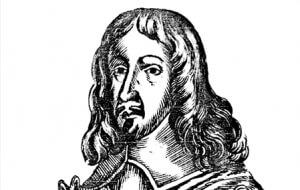
A staunch Puritan, Brereton was appointed commander-in-chief of Parliament’s forces in Cheshire, Shropshire, Lancashire and Staffordshire. Brereton is best known for commanding the long-drawn-out siege of Chester starting in the fall of 1644, which was defended by Lord Byron. The siege was so important to the Parliamentarian cause that Brereton was one of the few commanders allowed to retain both his military command and his Parliamentary seat after the Self-Denying Ordinance of April 1645. Chester surrendered in January 1646. Brereton also received the surrender of the last Royalist army under Sir Jacob Astley in March 1646. He declined to sit as one of the king’s judges in 1649 and retired from politics during the Commonwealth and Protectorate.
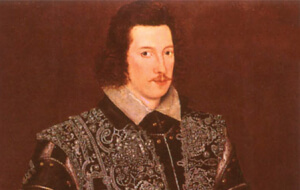
The Earl of Essex was the commander-in-chief of Parliamentary forces from the start of the war until the Self-Denying Ordinance of 1645 (when members of Parliament either gave up their military commands or their Parliamentary seat – except, significantly, for Cromwell and a few other Members of Parliament). Essex lost the battle of Edgehill, but was later able to force Charles to retreat at Newbury. He lost his army at Lostwithiel in 1644 and then resigned his commission in 1645.
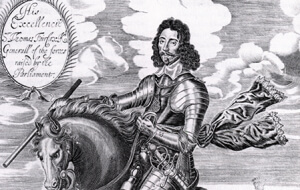
Fairfax was the eldest son of Ferdinando Fairfax, 2nd Lord Fairfax of Cameron. Sir Thomas was the most successful Parliamentarian general of the First and Second Civil Wars and Lord-General of the New Model Army, with Oliver Cromwell as his Lieutenant General. Fairfax, though a great soldier and loved by his troops, was uncomfortable with politics and refused to take part in the trial of Charles I. He also refused to fight against Charles II in the Third Civil War and supported the Restoration.
Lambert began the war as a captain in Sir Thomas Fairfax’s regiment of cavalry. By 1643 he was the colonel of his own regiment and went on to lead troops at Nantwich and Marston Moor. In 1647 he was promoted to Major General and became the third in command of the Parliamentarian army at the age of 28. Lambert played a prominent part in the Second Civil War under Cromwell and supported Cromwell’s elevation to Lord Protector. He was imprisoned after attempting to resist the Restoration, and he spent the remainder of his life as a prisoner.

In 1620, Waller joined Sir Horace Vere’s expedition to the Palatinate to rescue Elizabeth of Bohemia (King Charles’ sister and mother of Prince Rupert). Sir Ralph Hopton and Waller served as members of Elizabeth’s lifeguard at Prague. After the defeat of the Bohemians (November 1620), they escorted Elizabeth and her children their escape to Frankfurt. Waller raised a cavalry regiment at the start of the war, and was defeated by his friend Sir Ralph Hopton several times (he eventually defeated Hopton at Cheriton). Waller was instrumental in suggesting that a standing professional army – what would become known as the New Model Army – be formed. Waller retired from military service after the Self-Denying Ordinance of 1645 and later worked for the Restoration.
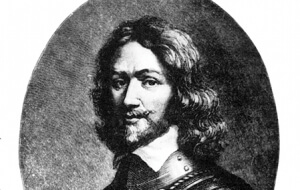
Ireton raised a troop of cavalry at the start of the war in 1642, and became a colonel by 1644. He fought at Second Newbury and Marston Moor and was wounded and captured at the battle of Naseby in 1645. He married Cromwell’s eldest daughter in 1646. Ireton was a staunch Puritan and worked closely with Cromwell in the army and in Parliament, including signing the king’s death warrant in 1649. He died in Ireland of the plague in1651 while serving as Lord Deputy of Parliamentary forces in Ireland.
Scots
Leslie was a very experienced leader who had served as a commanding officer for the Swedish King Gustavus Adolphus during the Thirty Years War. He returned to Scotland as a Swedish field marshal in 1637. After accepting a command from Charles I against the Irish rebels in 1641, Leven returned from Ireland to Scotland and was chosen to lead the Covenanter forces against the king. He led the Scottish forces allied with Parliament during the First English Civil War from 1644-46.
Montrose, after first fighting against Charles I in the Bishop’s War in 1640, was pardoned and afterward became a staunch Royalist. When the Scots entered the First Civil War in alliance with Parliament in 1644, Montrose raised a small force of 2,000 men in the Scottish Highlands. He used these troops to win several victories against great odds, which embarrassed the Scottish government and earned him a reputation as a great military leader. He was finally defeated at Philipbaugh in September 1645, just as Charles I was on his way to join him. Montrose escaped into exile, but returned to Scotland to raise troops for Charles II, who disowned him due to negotiations he was conducting with the Scottish government. Montrose was captured and executed in Edinburgh in 1650, shortly before Charles was proclaimed king by the Scottish government.
Original Panel
